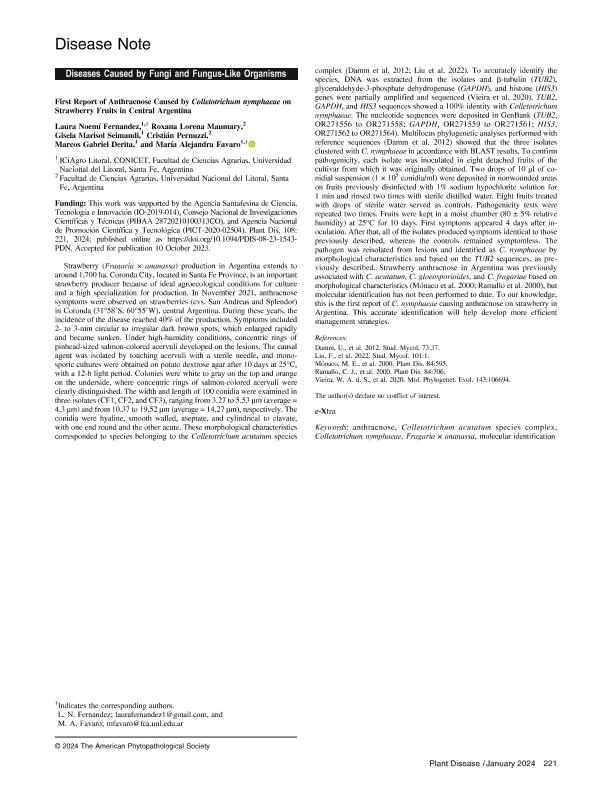Mostrar el registro sencillo del ítem
dc.contributor.author
Fernandez, Laura Noemí

dc.contributor.author
Maumary, Roxana Lorena

dc.contributor.author
Seimandi, Gisela Marisol

dc.contributor.author
Pernuzzi, Cristian Raúl

dc.contributor.author
Derita, Marcos Gabriel

dc.contributor.author
Favaro, María Alejandra

dc.date.available
2024-02-06T15:28:47Z
dc.date.issued
2023-10
dc.identifier.citation
Fernandez, Laura Noemí; Maumary, Roxana Lorena; Seimandi, Gisela Marisol; Pernuzzi, Cristian Raúl; Derita, Marcos Gabriel; et al.; First Report of Anthracnose Caused by Colletotrichum nymphaeae on Strawberry Fruits in Central Argentina; American Phytopathological Society; Plant Disease; 2024; 10-2023; 221-221
dc.identifier.issn
0191-2917
dc.identifier.uri
http://hdl.handle.net/11336/226014
dc.description.abstract
Strawberry (Fragaria x ananassa) production in Argentina extends to around 1700 hectares. Coronda city, located in Santa Fe province, is an important strawberry producer due to ideal agroecological conditions for culture and a high specialization for production. In November 2021, anthracnose symptoms were observed on strawberries cvs. ‘San Andreas’ and ‘Splendor’ in Coronda (31°58’S, 60°55’W), central Argentina. During these years, the incidence of the disease reached 40% of the production. Symptoms included 2-3 mm circular to irregular dark brown spots which enlarged rapidly and became sunken. Under high humidity conditions, concentric rings of pinhead-size salmon-colored acervuli developed on the lesions. The causal agent was isolated by touching acervuli with a sterile needle and monosporic cultures were obtained on PDA after 10 days at 25°C, with a 12-h light period. Colonies were white to gray on the top and orange on the underside, where concentric rings of salmon acervuli were clearly distinguished. The width and length of one hundred conidia were examined in three isolates (CF1, CF2, and CF3), ranging from 3.27 to 5.53 μm (avg.= 4.3 μm), and from 10.37 to 19.52 μm (avg.= 14.27 μm), respectively. The conidia were hyaline, smooth-walled, aseptate, and cylindric-clavate with one end round and one end acute. These morphological characteristics correspond to species belonging to the C. acutatum complex (Damm et al. 2012; Liu et al. 2022). To accurately identify the species, DNA was extracted from isolates, and ß-tubulin (TUB2), glyceraldehyde-3-phosphate dehydrogenase (GAPDH), and histone (HIS3) genes were partially amplified and sequenced (Vieira et al. 2020). TUB2, GAPDH, and HIS3 sequences presented a 100% of identity with species of Colletotrichum nymphaeae. The nucleotide sequences were deposited in GenBank (OR271556-OR271558, TUB2; OR271559-OR271561, GAPDH; and OR271562-OR271564, HIS3). Multilocus phylogenetic analyses performed with reference sequences (Damm et al. 2012) showed that the three isolates clustered with C. nymphaeae, in accordance with BLAST results. To confirm pathogenicity, each isolate was inoculated in eight detached fruits of the cultivar from which it was originally obtained. Two drops of 10 μl of conidial suspension (1x105 conidia per ml) were deposited in non-wounded areas on fruits previously disinfested with 1% sodium hypochlorite solution for 1 min and rinsed twice with sterile distilled water. Drops of sterile water were deposited in eight fruits as control. Pathogenicity tests were repeated twice. Fruits were kept in moist chamber (80+5% relative humidity) at 25°C for ten days. First symptoms appeared 4 days after inoculation. After that, all of the isolates produced symptoms identical to those previously described, whereas the controls remain symptomless. The pathogen was re-isolated from lesions, and identified as C. nymphaeae by morphological characteristics and based on the TUB2 sequences, as previously described. Strawberry anthracnose in Argentina was previously associated with Colletotrichum acutatum, C. gloeosporioides and C. fragariae species based on morphological characteristics (Ramallo et al. 2000; Monaco et al. 2000) but molecular identification was not performed until today. To our knowledge, this is the first report of C. nymphaeae causing anthracnose on strawberry in Argentina. This accurate identification will help to develop more efficient management strategies.
dc.format
application/pdf
dc.language.iso
eng
dc.publisher
American Phytopathological Society

dc.rights
info:eu-repo/semantics/openAccess
dc.rights.uri
https://creativecommons.org/licenses/by-nc-sa/2.5/ar/
dc.subject
COLLETOTRICHUM ACUTATUM SPECIES COMPLEX
dc.subject
MOLECULAR IDENTIFICATION
dc.subject
ANTHRACNOSE
dc.subject
FRAGARIA X ANANASSA
dc.subject.classification
Otras Ciencias Agrícolas

dc.subject.classification
Otras Ciencias Agrícolas

dc.subject.classification
CIENCIAS AGRÍCOLAS

dc.title
First Report of Anthracnose Caused by Colletotrichum nymphaeae on Strawberry Fruits in Central Argentina
dc.type
info:eu-repo/semantics/article
dc.type
info:ar-repo/semantics/artículo
dc.type
info:eu-repo/semantics/publishedVersion
dc.date.updated
2024-02-05T13:44:27Z
dc.journal.volume
2024
dc.journal.pagination
221-221
dc.journal.pais
Estados Unidos

dc.description.fil
Fil: Fernandez, Laura Noemí. Consejo Nacional de Investigaciones Cientificas y Tecnicas. Instituto de Ciencias Agropecuarias del Litoral. - Universidad Nacional del Litoral. Instituto de Ciencias Agropecuarias del Litoral.; Argentina
dc.description.fil
Fil: Maumary, Roxana Lorena. Consejo Nacional de Investigaciones Cientificas y Tecnicas. Instituto de Ciencias Agropecuarias del Litoral. - Universidad Nacional del Litoral. Instituto de Ciencias Agropecuarias del Litoral.; Argentina
dc.description.fil
Fil: Seimandi, Gisela Marisol. Consejo Nacional de Investigaciones Cientificas y Tecnicas. Instituto de Ciencias Agropecuarias del Litoral. - Universidad Nacional del Litoral. Instituto de Ciencias Agropecuarias del Litoral.; Argentina
dc.description.fil
Fil: Pernuzzi, Cristian Raúl. Universidad Nacional del Litoral. Facultad de Ciencias Agrarias; Argentina
dc.description.fil
Fil: Derita, Marcos Gabriel. Consejo Nacional de Investigaciones Cientificas y Tecnicas. Instituto de Ciencias Agropecuarias del Litoral. - Universidad Nacional del Litoral. Instituto de Ciencias Agropecuarias del Litoral.; Argentina
dc.description.fil
Fil: Favaro, María Alejandra. Consejo Nacional de Investigaciones Cientificas y Tecnicas. Instituto de Ciencias Agropecuarias del Litoral. - Universidad Nacional del Litoral. Instituto de Ciencias Agropecuarias del Litoral.; Argentina
dc.journal.title
Plant Disease

dc.relation.alternativeid
info:eu-repo/semantics/altIdentifier/doi/http://dx.doi.org/10.1094/PDIS-08-23-1543-PDN
dc.relation.alternativeid
info:eu-repo/semantics/altIdentifier/url/https://apsjournals.apsnet.org/doi/10.1094/PDIS-08-23-1543-PDN
Archivos asociados
